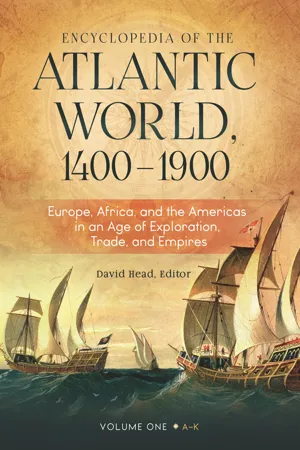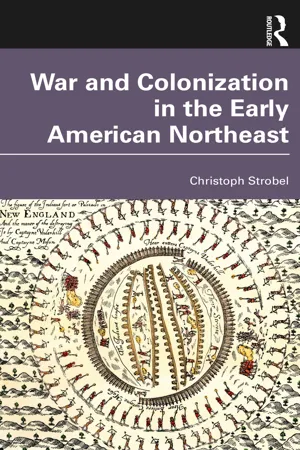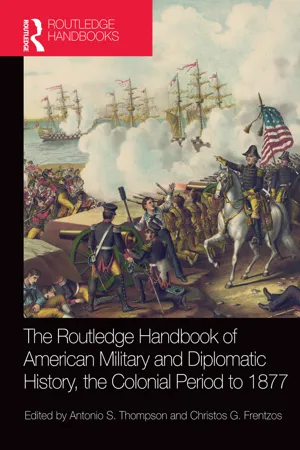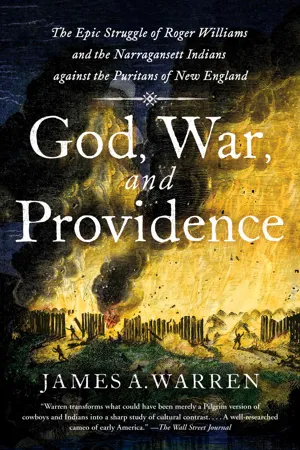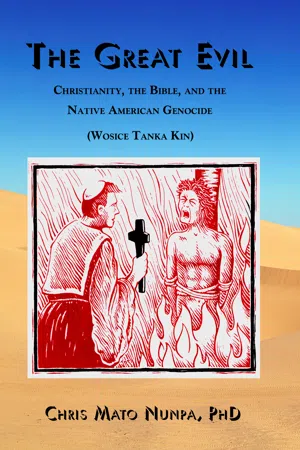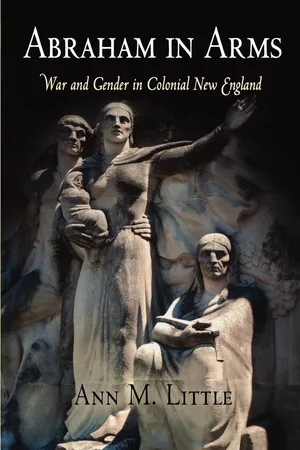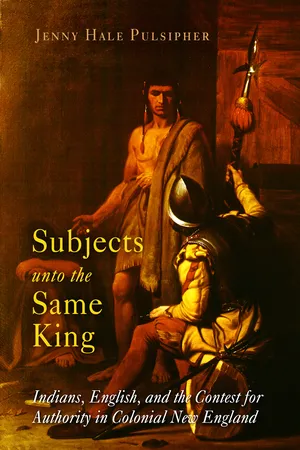History
Pequot War
The Pequot War was a conflict in 1637 between the Pequot tribe and English colonists and their Native American allies in present-day Connecticut. It resulted in the near destruction of the Pequot tribe and marked a turning point in the colonization of New England, as it allowed the English to expand their control over the region.
Written by Perlego with AI-assistance
Related key terms
Related key terms
1 of 4
Related key terms
1 of 3
12 Key excerpts on "Pequot War"
- eBook - ePub
Encyclopedia of the Atlantic World, 1400–1900
Europe, Africa, and the Americas in an Age of Exploration, Trade, and Empires [2 volumes]
- David Head, David Head, David Head(Authors)
- 2017(Publication Date)
- ABC-CLIO(Publisher)
Like a Hurricane: The Indian Movement from Alcatraz to Wounded Knee . New York: New Press.PARIS, TREATY OF. See Treaty of Paris (1763)Pequot War (1636–1637)The Pequot War was a brutally violent conflict between Native Americans and English settlers in New England from 1636 to 1637. Although the war is often seen as a contest over land, it was primarily a struggle over the lucrative traffic in furs and wampum between North America and Europe. The origins of the conflict also stretched as far back as 1620, when religious refugees known as the Separatists (or Pilgrims) fled England for North America where they established a settlement at Plymouth. Soon after, a group of Puritans from England followed suit and founded the Massachusetts Bay colony in 1630, which expanded in 1636 to include the Connecticut or “River” colony. As recent immigrants, the English often found themselves caught up in the rivalries between New England’s native peoples, such as the Pequot and Mohegan, and nearby Europeans, such as the Dutch, who traded with each other. Ultimately, the Pequot War was the culmination of a series of events, misunderstandings, and violence that resulted from competing native and European efforts to control the region’s trade.Initially, the Pequot Indians dominated the flow of furs and wampum in and out of New England to Europe, a monopoly they maintained with the support of the Dutch colony in New Netherland (present-day New York state and surrounds). The Pequot carved out such control through an expansive tributary system, in which they forced surrounding native peoples to offer up annual tributes in exchange for protection and access to the Pequot-Dutch trade. However, the arrival of English immigrants to New England threatened the Pequot-Dutch trade as English traders attempted to penetrate the monopoly. To offset the English threat, the Pequot embarked on a series of violent, complex episodes in the early 1630s that collectively led to war. - Christoph Strobel(Author)
- 2023(Publication Date)
- Routledge(Publisher)
19The Pequot War enabled the colonists to strengthen and reinforce their position in Connecticut, but it also helped to shape New England’s colonial racial order. The English and their Native American allies led a disproportionately violent and punitive campaign against the Pequot, which included the slaughter of non-combatants. English colonists also summarily executed Pequot prisoners of war. The success of the English and their Native American allies was brought about through a war of attrition that assisted the brutal defeat of the Pequot nation. In addition, the war resulted in the introduction of several hundred Pequot War captives to the English colonies, seen by the English at least, as compensation for the costs they had incurred for fighting a “just war.” Many Pequot prisoners of war were used as unfree labor, while others were sold into the Caribbean, a practice that continued in other conflicts during the seventeenth century. In exchange for the Pequot captives, the English also brought people of African descent to Massachusetts Bay, a development that tied the New England colony in the Atlantic World slavery complex. The debate over the legal status of the Pequot prisoners of war, as well as the presence of people of African descent, argues historian Margret Newell, was instrumental in Massachusetts Bay Colony being the first English-speaking colony in North America to codify the enslavement of Indigenous and black peoples in the early 1640s.20In the decades after the defeat of the Pequot nation, the colonies of Massachusetts Bay, Connecticut, New Haven, and Plymouth increasingly focused their indignation on the Narragansett tribe, living in what is today the state of Rhode Island. The Narragansett people were one of the more populous nations in southern New England. Through shrewd diplomacy and reciprocity, they created a network of allies among various communities in the Indigenous Northeast. Throughout the late 1630s to the 1670s, there were various tense flashpoints between English colonies and the Narragansett nation. Before King Philip’s War, the Narragansett people and their allies never directly engaged in military conflict with the English. Still, there were several violent confrontations between the Narragansett alliance system and the Mohegan tribe, who were closely allied with the English colonies.- eBook - ePub
Drawdown
The American Way of Postwar
- Jason W. Warren(Author)
- 2016(Publication Date)
- NYU Press(Publisher)
Part IBuilding the American Military Ideal
Passage contains an image
1
The Art of War
Early Anglo-American Translation, 1607–1643
Kevin McBride with Ashley BissonnetteTwo paradigms dominate the historiography of the Pequot War (1636–1637)—the earliest war fought between English colonists and Native Americans in northeastern North America.1 The first is that Indigenous warfare in southern New England, described as “a Skulking Way of War,” was kin based and ritual in nature with limited goals and objectives that were primarily related to revenge, prestige, and captive taking, and resulted in relatively few casualties.2 A corollary of this perspective is that southern New England was a relatively peaceful place until the arrival of Europeans in the early seventeenth century, after which Native groups began to compete for dominance in the fur and wampum trade. The second paradigm is that New England (primarily Connecticut) colonists who decisively defeated the Pequot, at the time the most powerful tribe in southern New England, were with the exception of a few experienced officers ill trained and inexperienced men drawn from trainbands and provided with weapons they barely knew how to use. In this narrative, the colonists achieved victory over the Pequot largely because of superior military technology and, from a colonial perspective, “Gods Providence.”3Neither of these perspectives accurately portrays the events and conduct of the Pequot War, nor how 77 Connecticut soldiers and 250 Mohegan, Wangunk, and Narragansett allies were able to march into the middle of Pequot country and decisively defeat the Pequot, who could field almost a thousand men against the English and allied Indian force. Connecticut’s decisive victory over the Pequot in the Mistick Campaign was a radical departure from the existing Anglo-American military-militia system in a number of ways. The campaign drew heavily upon the ranks of combat veterans in the Connecticut settlements, relied heavily on their native allied contingent for support and intelligence, and adapted European weapons and tactics to the enemy and terrain of the New England frontier. The Mistick Campaign (May 18–May 27, 1637) was the decisive campaign of the war, and consisted of two battles fought over an eighteen-hour period. The Pequot lost more than five hundred warriors in these battles, virtually destroying their military capability and leading to their defeat and near annihilation six weeks later. - eBook - ePub
The Routledge Handbook of American Military and Diplomatic History
The Colonial Period to 1877
- Christos G. Frentzos, Antonio S. Thompson(Authors)
- 2014(Publication Date)
- Routledge(Publisher)
Despite its ruthlessness, the aftermath of the Pequot War seemed to seventeenth-century writers to have demonstrated the worth of Puritan actions, as the war was followed by a half-century of general peace between Indian and Anglo communities. Yet, this apparent peace was undercut by persistent alarms and rumors of Indian conspiracies. Tension between Narragansetts and Mohegans was visible even at the time of the Hartford Treaty, and escalated as the two groups quarreled over their respective allotments of Pequot captives. By 1642, the Mohegans and Narragansetts were at war, and the New England colonies fretted about rumors of grand Indian conspiracies throughout the 1650s and 1660s.Possibly the worst consequence for the Puritans might have been that the Pequot War may have helped lead, diplomatically and militarily, to a far worse Indian conflict in the 1670s. King Philip’s War began in June 1675, when Wampanoag leader Metacom, known to the English as Philip, attacked Plymouth Colony. The conflict lasted for 14 months, and for most of the war, Philip and his allies appeared to be winning. Casualties were high on both sides. Virtually every building in Rhode Island was burned except for those on Aquidneck Island, and every Massachusetts settlement except Boston was attacked. The hostage distribution at the Pequot War’s end and the favoring of the Mohegans over the Narragansetts fostered long-standing animosities that may have helped push many tribes into alliance with Philip. Even more significantly, the Pequot War may have driven the Indians into a type of total war that they previously did not practice. Military historian Adam Hirsch sees the Pequot War as a watershed event that permanently changed the nature of Indian-European warfare. The Indians learned hard-won lessons, including the effectiveness of attacking settlements and crops. Indians groups also learned from the Pequot War that any fight with the Europeans was a fight to the death.23Notes
1Jill Lepore, The Name of War: King Philip’s War and the Origins of American Identity (New York: Knopf, 1998), ix. The title is from William Bradford’s description of the attack on Fort Mystic: “It was a fearfull sight to see them thus frying in the fyer, and the streams of blood quenching the same, and horrible was the stink and scent thereof.”: William Bradford, Plymouth Plantation, 1620–1647 - eBook - ePub
- Peter Karsten, Peter Karsten(Authors)
- 2013(Publication Date)
- Routledge(Publisher)
62 Such appraisals miss the war’s deeper cultural significance: From the standpoint of military acculturation, it was a watershed. The final period assayed in this study, 1637-1676, illustrates how initial cultural contact in the Pequot War left its imprint on the region’s subsequent military affairs.In one sense, the meeting of military cultures in the Pequot War was progressive in character: It facilitated the exchange of knowledge necessary for informed dealings between New England’s native ana colonial societies. Impolicies born of cultural ignorance — such as the settlers’ decision to dispatch the Endicott expedition and the Pequots’ decision to retaliate within traditional limits — therefore promised to be transient phenomena, irreversible in the event but incapable of repetition once cultural contact had disabused policy makers of their misperceptions.Puritan settlers may have been a stubborn lot, but they would not close their eyes to stark reality. Having discovered in 1636 that precipitous military action against Indians could easily provoke hostilities, colonial leaders relied thereafter on other, safer vehicles of statecraft. Like most lessons learned through bitter experience, this was a dictum that John Winthrop took to heart. When the Connecticut Council in 1642 urged Winthrop, then governor of Massachusetts, to join in a preemptive strike against allegedly disloyal Indians, the suggestion opened an old wound. Winthrop responded thatOur beginning with them could not secure us against them; we might destroy some part of their corn and wigwams, and force them to fly into the woods, etc., but the men would be still remaining to do us mischief, for they will never fight us in the open field.That hard-earned wisdom prevailed.63Nor were the settlers alone in their appreciation of the Pequot War’s harsh lessons. Native leaders proved quick studies, and their military policies after 1637 stood shorn of the naivete so strikingly evident during the conflict. Even before the war erupted, Indians had shaken off their exaggerated fear of English firearms. And after the dust had settled in 1637, they understood all too well that conflict with the settlers meant war to the death. New England’s native governments refrained from challenging their colonial neighbors for the next thirty-eight years, and al though the Wampanoags’ decision to launch King Philip’s War in 1675 was certainly a reckless (or desperate) act. it was not an ignorant one. Philip fully comprehended that “he could expect no mercy” in the event of failure. His eventual defeat stemmed from the hopelessness of his cause, not from paucity of effort. That was one indiscretion the Wampanoags refused to repeat.64 - eBook - ePub
Dutch and Indigenous Communities in Seventeenth-Century Northeastern North America
What Archaeology, History, and Indigenous Oral Traditions Teach Us about Their Intercultural Relationships
- Lucianne Lavin, Lucianne Lavin(Authors)
- 2021(Publication Date)
- SUNY Press(Publisher)
In response, the English declared an Offensive War against the Pequot on May 1, 1637 and made plans to attack the Pequot fortified village at Mystic with a force of seventy-seven English soldiers and 250 Mohegan, Narragansett, Eastern Niantic, and Wangunk allies. The surprise dawn attack took place on May 26, 1637 and resulted in the deaths of four hundred Pequot men, women, and children, half of whom burned to death. The Battle of the English Withdrawal began a few hours later and consisted of a 4.5-mile, ten-hour fighting retreat against hundreds of Pequot fighting men who had mobilized after the Mistick Fort Battle in one of the longest and most intense battles of the Pequot War. 2 Pequot Expansion, 1620–1631 Within a decade after the arrival of Dutch traders in 1611, the Pequot positioned themselves to control the fur and wampum trade over much of Long Island Sound and the Connecticut River Valley. Pequot hegemony was achieved through warfare, coercion, subjugation, and alliance building to dominate key territory and resources. Wampum (purple and white shell beads made from hard shell clam and northern whelk) from eastern Long Island Sound quickly became the most important component of the fur trade, as it was in great demand by tribes in the fur-rich interior areas of the Hudson and upper Connecticut River drainages. By the mid-1620s the Dutch acquired at least 150,000–200,000 wampum beads a year from tribes living along Long Island Sound for the northern fur trade. 3 The wampum-producing regions of eastern Long Island Sound between the Connecticut River and Narragansett Bay were the first areas to fall under Pequot control in the 1620s, followed by the middle Connecticut River Valley in the early 1630s - eBook - ePub
God, War, and Providence
The Epic Struggle of Roger Williams and the Narragansett Indians against the Puritans of New England
- James A. Warren(Author)
- 2018(Publication Date)
- Scribner(Publisher)
Chapter 4Troubles on the Frontier: The Pequot War
This extraordinarily detailed drawing of the attack on the Pequots’ fort at Mystic first appeared in John Underhill’s Newes from America , published in London in 1638. English troops are shown shooting unarmed Indians as Pequots struggle to escape beyond the English lines. The English way of war was far more destructive of human life than traditional Indian warfare, and it shocked and frightened the natives.I n the early 1630s, the Narragansetts found themselves engaged in on-again, off-again warfare with their perennial enemies to the west, the Pequots, for the loyalty and tribute of the small bands of Indians who lived on the Connecticut River, and for control over the land between the Pawcatuck and Thames Rivers. These Narragansett-Pequot clashes were part of a larger, regional conflict that drew in a small number of Dutchmen hunkered down at a trading post near modern Hartford, English traders from Plymouth Plantation, several hundred settlers from Massachusetts Bay intent on establishing a new colony on the Connecticut River, and the Pequots’ disaffected kindred tribe, the Mohegans, led by Uncas. That wily sachem was then busily poaching bands from the Pequot sachem Tatobem’s orbit, having failed to gain the Pequot sachemship for himself, despite several spirited attempts.The Pequots’ attacks on the river tribes that had formerly been their tributaries forced those Indians to seek protection from either the Narragansetts or the Mohegans, both of whom took to the warpath against the Pequots. In early 1634, the Pequots killed several members of a Narragansett party attempting to trade with the Dutch at their trading post. Eager to preserve their highly profitable trade relationship with the Narragansetts, the Dutch responded swiftly. They captured Tabotem and held him for ransom. A ransom was paid by the Pequots, but a bit too late: the Dutch handed over Tatobem’s corpse rather than the man. - eBook - ePub
- Armstrong Starkey(Author)
- 2002(Publication Date)
- Routledge(Publisher)
4 The central incident of that conflict had been the massacre of a Pequot village near Mystic, Connecticut by an English force with an overwhelming superiority in firearms. The Pequot War introduced the New England Indians to the full fury of the European way of war and may have influenced the tactics they employed in 1675–6. It also exposed a critical weakness in any Indian attempt to oppose European settlement. Although the New England Indians were all members of the Algonquian language group and shared a common culture, they were deeply divided by political and commercial rivalries. The Pequot dominance over the fur trade in the Connecticut River valley was much resented by their neighbours and their appeals to form a common front against the Europeans fell on deaf ears. When the English military expedition marched into Pequot territory, it was accompanied by a large party of neighbouring Narragansetts. The Narragansetts’ turn would come on 19 December 1675 when, in a battle known as the Great Swamp Fight, a fierce English assault devastated a fortified Narragansett village. Ironically, the Connecticut soldiers participating in this attack were accompanied by a detachment of Pequot Warriors.Peace and commerce, however, were characteristics of white-Indian relations during the first half-century of settlement. Indians supplied their English neighbours with food, furs and land in exchange for a variety of European goods including weapons. The integration of the Indian and colonial economies in the decades before 1650, a period one writer refers to as the “golden age of trade”, was symbolized by the appearance of wampum, strings of Indian-produced decorative shells as a fur-backed currency of exchange widely accepted by all of the peoples of New England. The subsequent decline in the demand for beaver pelts and the collapse in the value of wampum seems to have provided an economic context for increasingly strained white—Indian relations in the third quarter of the century.5 Nevertheless, one does not have to be a disciple of the classical economists to conclude that commerce had long exercised a peaceful influence in New England. On the other hand, the primary source of wealth in seventeenth-century New England was agriculture rather then commerce. Massachusetts’ and Connecticut’s designs upon the land occupied by Rhode Island dissenters and Narragansett Indians brought southern New England to the brink of war in the 1640s.6 - eBook - ePub
- Christoph Strobel(Author)
- 2020(Publication Date)
- Praeger(Publisher)
Given the declining options and increasing frustrations with New English aggressive demands, several indigenous communities heeded the Wampanoag sachem’s appeal. It was younger indigenous men, who made up the backbone of Native American military forces, who felt especially threatened by the loss and decreasing access to hunting and fishing grounds, developments that undercut and threatened their contributions to their communities. But such frustrations were also felt more broadly throughout many indigenous towns and villages. Such exasperations undoubtedly centered on the continuous efforts to try to work out compromises with the colonizers, negotiations that seemed to time and again lead to renewed New English demands for land and other encroachments on indigenous resources and established ways. The New English presence had increasingly undercut traditional gendered roles and sources of power that had long been established in indigenous societies. To a number of Native American communities in southern New England, war seemed increasingly the only way to resist English demands and attempt to strengthen their communities, cultures, and lifeways.King Philip’s War was, however, not a war between New English colonists on the one side and Native Americans on the other but instead was a complicated intercultural conflict. In southern New England, anticolonial resistance gained wide support among the Wampanoags, Narragansetts, and Nipmucs. Many Pequots, Mohegans, and Niantics, on the other hand, did not join the anti-English resistance and often supported the New English colonies in military campaigns. In addition, while the majority of New England praying towns either sided with the colonists or attempted to stay outside the conflict, some praying town residents joined the militant resistance.Native American allies played a crucial role in the defense of the New English colonies during King Philip’s War. Eliot’s and Gookin’s influence probably played a role in the decision of some praying town natives to side with the English. But the location of these praying towns might have played an ever more important role. Many of these communities were either completely surrounded by or in close vicinity to colonial settlements, which steered them toward seeking a close association with Massachusetts Bay Colony. That said, not all praying towns pursued this strategy. Some of the communities that were far enough away from a direct English threat joined the anticolonial resistance. Groups such as the Mohegans, Pequots, and Niantics had different motivations for joining with the New English shaped by their earlier experiences. They felt that an alliance with the English would serve their strategic purposes better and would help to strengthen their regional position, which motivated these nations to affirm their established alliances with the English. - eBook - ePub
The Great Evil
Christianity, the Bible, and the Native American Genocide
- Chris Mato Nunpa(Author)
- 2020(Publication Date)
- See Sharp Press(Publisher)
45 So, when the whites decided on an aggressive policy against the Pequots, other native peoples either remained neutral or joined the white man against the Pequots in May 1637.The Pequots, on the other hand, were an independent and sovereign people who distrusted the English, for good reason. After a number of incidents in the 1630s in which some whites were killed, the Connecticut General Court met and declared war on the Pequots on May 1, 1637. Or, as Ward Churchill writes, “the leadership of both Plymouth and Massachusetts collaborated with that of the unofficial colony of Connecticut to fabricate a pretext, and then set out on a war of extermination.”46The Pequots, under the leadership of Sassacus, retaliated, killing 30 whites and taking women and children captive, and then retreated to their palisaded town on the Mystic River.Massachusetts sent Captain John Endicott to Block Island, off the coast of Rhode Island, where his task was “to kill every adult male residing there and capture as many women and children as possible, since “they would fetch a tidy sum in the West Indies slave markets.”47 The Pequots at Block Island did not engage the English and instead “simply melted away into the woods.” The “frustrated English vented their racial fury and blood-lust by burning homes and fields.”48On the mainland, Captain John Mason, who had been appointed commander of the Connecticut troops, launched his attack on May 26, 1637 against the Pequots. The whites, with their native allies, attacked the town, setting fire to it, slaying men, women, and children as they fled the flames. The Narragansett People, one of the “native allies” who had long been at odds with the Pequots, accompanied Mason’s troops. However, when the Narragansetts found out that Mason was planning nothing less than a wholesale massacre, they withdrew to the rear. Mason at the head of one of the attacking parties, and John Underhill leading the other, under cover of pre-dawn darkness, attacked the unsuspecting Pequots from two directions at once. The British swarmed into the Pequot town, slashing and shooting at anything that moved. Caught off guard, and with apparently few warriors in the community, some of the Pequots fled, “others crept under their beds,” while still others fought back “most courageously.” This only drove Mason and his men to greater fury. “We must burn them,” Mason later recalled himself shouting,49 - eBook - ePub
Abraham in Arms
War and Gender in Colonial New England
- Ann M. Little(Author)
- 2013(Publication Date)
- University of Pennsylvania Press(Publisher)
Despite the bias of English narratives, there are consistent similarities that support the notion that war was an important proving ground for Indian men. Like English men, Indian men were proud of being brave warriors and of being known and respected as courageous in battle. Captain John Underhill describes the Indians he fought in an early engagement on Block Island as “able fighting men, men as straite as arrowes, very tall, and of active bodies.” English observers recognized that even the vilified Pequot had among them “many courageous fellowes,” who in the climactic torching of the Pequot village were “unwilling to come out, and fought most desperately through the Palisadoes, so as they were scorched and burnt with the very flame … and so perished valiantly.” 41 The English men involved in the Pequot War were generally impressed by the professed willingness of their Mohegan allies to join the fight, and by their pledges of brave soldiering. Some English reports emphasize the willingness of the allied Indians to put themselves under English command, as in Underhill’s discussion of the Mohegan alliance: “These Indians were earnest to joyne with the English, or at least to bee under their conduct… [promising] to be faithfull, and to doe [the English] what service lay in their power.” Presumably, this supposed willingness to accept English notions of hierarchy, with English leadership on top, made the Mohegans very appealing allies. In his description of Uncas, Captain John Mason appreciatively reports that the Mohegan sachem predicted “the NARRAGANSETTS would all leave us, but as for HIMSELF He would never leave us: and so it proved: For which Expressions and some other Speeches of his, I shall never forget him - eBook - ePub
Subjects unto the Same King
Indians, English, and the Contest for Authority in Colonial New England
- Jenny Hale Pulsipher(Author)
- 2014(Publication Date)
- University of Pennsylvania Press(Publisher)
Chapter 5The “Narragansett War”
Fall 1675 was a doleful season for the colonists of New England. The Pocumtucks’ and Nipmucks’ flight had been followed by a series of devastating attacks on outlying English towns—Deerfield, Squakeag, Northampton, Stony Brook, Springfield, and Hatfield, several of them more than once—and there was clear evidence both Pocumtucks and Nipmucks had taken part. The defection of these Indians heightened English anxiety about the faithfulness of the Indians remaining in friendship with them. The Narragansetts, in particular, were a source of grave apprehension, not only because they were the largest and most powerful group of Indians in the region but because of their long history of resisting English authority and insisting on a direct relationship to the king—their right as fellow subjects. Since the Pequot War the relationship between English authorities and Narragansett leaders had been a continual failure of expectations on both sides. That enduring conflict made the English less likely to trust Narragansett professions of fidelity during the war. The situation was further complicated by a simultaneous crisis of authority within the Narragansett community, with young and old pulling in opposite directions on whether to join Philip. Obligations of kinship, which crossed tribal lines, created a further conflict with authority because they clashed with English demands that the Narragansetts turn over all hostile refugees. Under threat of war, the Narragansetts’ persistent refusal to recognize English authority as final and to place English demands ahead of their own needs and obligations convinced the English that the Narragansetts were a perilous threat that must be crushed. And the Narragansetts’ insistence on their independence from local English authority—their direct relationship to the king—had spread, nourishing Philip’s and the Wampanoags’ actions as well as their own.
Index pages curate the most relevant extracts from our library of academic textbooks. They’ve been created using an in-house natural language model (NLM), each adding context and meaning to key research topics.
Explore more topic indexes
Explore more topic indexes
1 of 6
Explore more topic indexes
1 of 4
